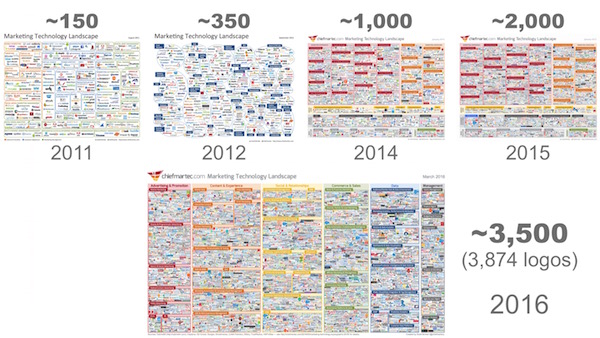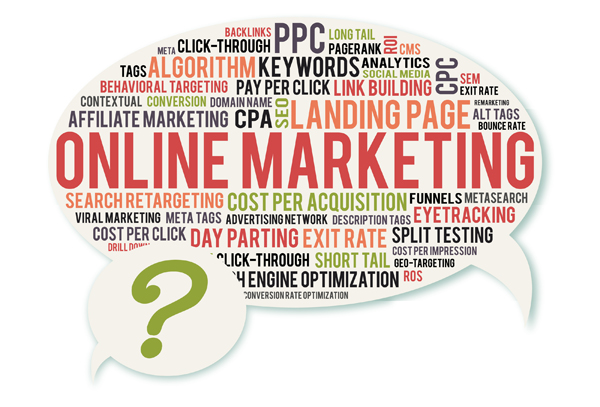The Digital Marketing Ecosystem
Originally posted on LinkedIn Pulse
For maybe the first time in history, there is a surplus of technology and strategy to help advance both sales and marketing of a business, while at the same time a lack of resources and understanding to utilize it to its fullest capacity.
I love these graphics by Scott Brinker.

That’s not to say that marketers are less educated or qualified, it’s just that they have become over specialized and often don’t pull back to see the larger picture. This gap between tools available and execution presents an opportunity for those that understand the entire ecosystem.
Every company needs a Marketing Technologist.
Marketing technologists (those that understand how it all fits together) will become invaluable as businesses adopt customer relationship management solutions, email service providers, content management systems, and big data. Closing the loop on marketing ROI becomes both easier and more complicated at the same time.
A common story almost every company goes through.

Many companies will send their execs or CMO to attend an industry event. They get fired up and buy into the latest marketing craze. They hear buzzwords like mobile marketing, SEO, retargeting, inbound marketing, or social media engagement. They come back, tell their senior leaders and their team. They all agree and it’s time to get started.
Then something happens… the team looks at each other and says “So, how are we going to do this?”
Most teams mistakenly start with an Email Service Provider.
Many marketers will likely start off with just one of the tactics. Many times the tactic is email, because it’s inexpensive and scalable. The reason an ESP is needed in the first place, is to ensure the sends don’t blocked by ISPs and has a professional look and feel for the brand. This is something you can’t get from Outlook or Gmail.
Basic questions:
- How big is the list of email addresses?
- What is the most amount of money can be allocated to an ESP per month?
- What’s the difference between MailChimp, Contactology, Responsys, Vertical Response, Constant Contact, ExactTarget, etc.?
Don’t forget to consider the Customer Relationship Management solution.
After a company chooses their ESP, they then have to track down where the data comes from. If the company has a CRM, then hopefully that was a question asked when choosing the ESP. If the company doesn’t have a CRM, maybe it’s time to choose one. The benefits of a CRM are numerous but common reasons for the investment are: visibility to sales activity, central location for customer data, efficiency of forecasting, and ability to work share more information with marketing.
Basic questions:
- How many users will be logging into the CRM?
- Do we want to be able to access our data in the cloud?
- What’s the difference between Salesformics, Oracle, Zoho, SalesForce, Sugar, etc?
- Does the CRM automatically sync “out of the box” with the chosen ESP?
- Does the ESP open and click activity flow back into the CRM?
The website needs a strong Content Management System.
Now that the infrastructure is almost built, it’s time to consider launching some marketing campaigns. Especially for B2B, it’s important to nurture your prospects by creating valuable content that informs and educates. Customers are increasingly self-sufficient and will take the time to do the research. If a company can add value to the buying process, they’re much more likely to continue the relationship and make the sale. As a marketing team, it’s essential to manage and publish content in a way that visitors find it.
The easiest solution is creating a web presence and a website. Most likely the company will already have one, but it’s often outdated or difficult to manage. That’s really because nobody ever considered a strong content management system that anyone (marketing) could contribute to.
Basic questions:
- Can anyone at the company update the website without knowing HTML?
- What content management system will allow for easy publishing of content?
- What is the difference between WordPress, SharePoint, Joomla, and Drupal?
- How do visitors subscribe their emails into my ESP from the website?
- How do leads flow from the website into the CRM?
- What value do tools like Unbounce or WuFoo add to the CMS?
- How is the website measuring website visitors?
- How does the content and CMS affect the SEO strategy?
- Does the content automatically publish to social media?
- Can visitors share the content on their social media accounts?
Marketing Automation is a significant sales booster.
Companies that are getting serious about digital marketing and about the results quickly find themselves with requirements that fall into the Marketing Automation world. They are certainly beyond the scope of the initial decision to launch email marketing campaigns. This often causes marketing teams to unfortunately backtrack and reevaluate their tools. The ESP is often decidedly not powerful enough. The CRM is missing essential data that could help close sales. Marketing is pushed to only pass over MQLs (marketing qualified leads) instead of the flood that frustrates the sales team. Without marketing automation, they don’t have the ability to create a Lead Score. This is when the decision is made to find a marketing automation solution.
Basic questions.:
- What can’t the ESP do that is a new requirement? Is the current ESP needed anymore?
- Does the marketing automation tool sync to the CRM?
- What actions can be automated through a workflow or program?
- How does lead data flow into the marketing automation tool?
- What is the difference between Act-on, Eloqua, Marketo, Hubspot?
Most customers are now engaging via their mobile devices.

In today’s Digital Marketing Ecosystem, it’s essential to empower mobile users. If a company has a website, it should be mobile friendly. All emails sent out should also consider mobile users as well. This needs to be considered so that visitors can consume your content anywhere and anytime. There are a few options to accomplish this and each has their pros and cons.
Basic questions:
- Should mobile website visitors see a different website altogether or a responsive version of the website?
- How do tools like BMobilize and DudaMobile work?
- What does it mean for an email to be optimized for mobile?
- How do tools like Litmus allow testing of mobile emails?
Now that the tools are falling into place, the costs need to be justified.

The next focus is often measurement and proving that these investments were worth it. Many marketing teams use some basic analytics like Google Analytics or Web Trends but they quickly realize that it’s not enough. Depending on the true goals of the marketing campaigns, it’s possible they need something more robust, such as: Core Metrics or MyBuys. These services serve up email triggers based on the users actions. But they certainly aren’t considered from the start. The marketing automation tool will certainly provide some additional insight as well.
Basic questions:
- What is the best way to measure engagement?
- What additional tools can increase the efficiency of our campaigns?
- What is the difference between Google Analytics, Web Trends, Core Metrics, MyBuys, etc.?
- Can the customer be tagged to measure their web and email activity?
The Marketing Technologist understands the big picture and makes it work.

There are a many moving pieces that need to work together seamlessly in order build and launch effective targeted digital marketing campaigns. Because of this, there is an opportunity gap for those that understand the whole picture and can do it the right way from the beginning. Marketing technologies will become invaluable as companies move into digital relationships with their prospects and customers.
They’ll be able to come in, ask many questions, identify the company goals and then say something like…
“The marketing engine infrastructure should be built on SalesForce CRM, HubSpot Marketing Automation, WordPress CMS, Google Analytics, Authority Rank, and Unbounce.”
“To launch campaigns, the team can obtain contacts from Data.com and generate content with WriterAccess. We’ll test advertising creative across AdRoll, Google AdWords, OutBrain.”
More importantly, the marketing technologist could facilitate the setup, configuration, and execution on this type of solution. Strategy is important, but a marketing technologist should have a lean, growth hacker mindset.
